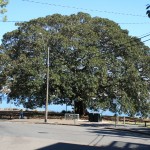Description
These two mature Moreton Bay Figs (Ficus macrophylla), located on a gently sloping open lawn area, visually dominate this foreshore reserve. Together these trees create a dramatic sense of place at this popular vantage point overlooking the harbour. The canopies and root zones appear to be contained within the reserve.
They have a height of 18-20m with a prodigious spread of 30-35m and quite massive trunks, measuring 2.2-2.4m at 1.4m (above the buttress flare). They appear to be in excellent health and condition.
Significance
These two mature Moreton Bay Figs (Ficus macrophylla) are significant as individual specimens in terms of their visual, historic and social values. Both figs are of massive proportions and are possibly the largest specimens of this species in the Glebe area.
They are highly significant components of the broader Glebe Point landscape and are clearly visible from the water (Rozelle Bay), adjoining streetscapes, old Glebe Island Bridge and Anzac Bridge.
They are truely landmark trees.
Historical notes
The reserve commemorates Pope Paul VI (1963-1978) and is part of a larger contiguous parcel of public foreshore open space on Glebe Point which includes Bicentennial Park and Jubilee Park (refer to listing in this Register).
The use of this species has parallels with other public parks throughout the City of Sydney LGA including the Domain, Centennial Parklands, Wentworth Park, Victoria Park and Prince Alfred Park. Moreton Bay Figs continue a lush, native evergreen/ broadleaf theme and provide high ornamental amenity and biodiversity values in this urban foreshore setting. They are clearly evident in the 1943 aerial photos of the area and are somewhat larger than other similar figs seen in the adjoining parklands, which would indicate they were planted slightly earlier and may date to the 1870’s or 1880’s.




















